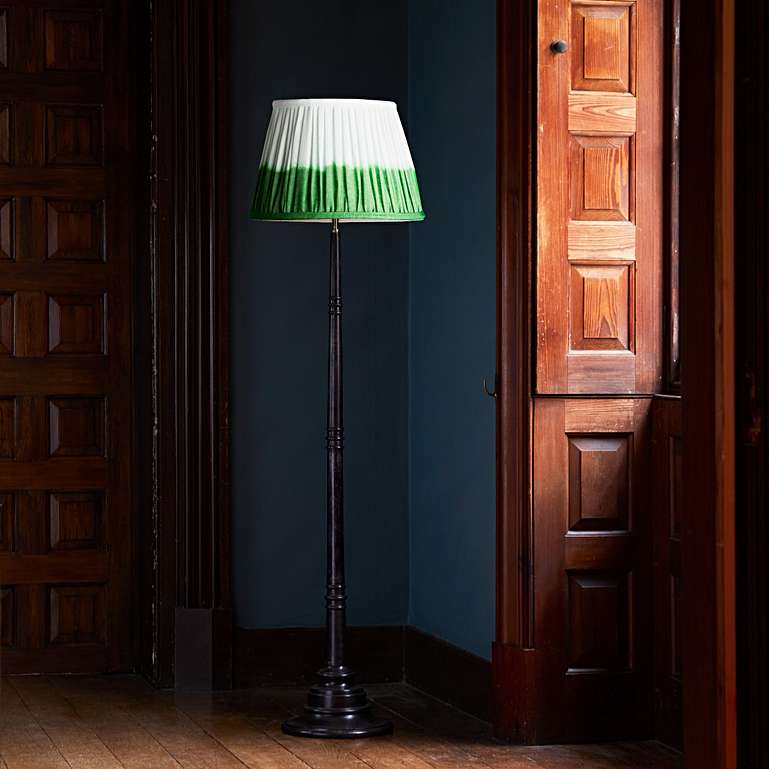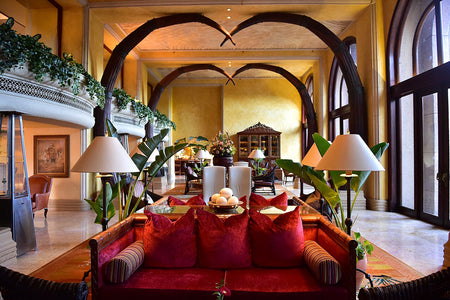Next in our series on the seminal interior design styles is Arts and Crafts - a cultural movement that still influences our ideas of home and beauty 150 years on...
The fact that the Arts and Crafts movement was rooted in reaction and rejection as well as in celebration may come as surprise. But it provides a clue to why a movement that spanned more than 60 years, from the second half of the 19th century to the first two decades of the 20th, continues to influence designers and makers over a century and a half later. So, what was the Arts and Crafts movement reacting against and rejecting; what was it celebrating, and why do its fundamental ideas remain so relevant in the digital world? In this post we’re visiting the Arts and Crafts world, meeting some of its most celebrated figures, and finding out how its aims and approaches still inform contemporary interior design – including Pooky lighting.
The Pomegranate Passage, Wightwick Manor, near Wolverhampton; Wightwick has one of the most complete surviving Arts and Crafts interiors ©NTPL/Paul Raeside
Arts and Crafts – the how, where and why
No figure epitomises the Arts and Crafts movement more than William Morris. His frequently quoted maxim that you should, ‘Have nothing in your houses that you do not know to be useful, or believe to be beautiful,’ has been a mantra for generations of designers. But you can’t talk about William Morris without mentioning John Ruskin, the writer who made his contemporaries sit up and take notice of the seemingly relentless march of mechanisation and industrialization, and of what this march threatened to destroy – for ever.

William Morris; John Ruskin
Their bête noire was Prince Albert’s Great Exhibition of 1851, which stood for so much that Morris and Ruskin detested. They believed that intensive industrial production not only reinforced poverty and squalor but would lead to the loss of valuable craft skills and, ultimately, to the crushing of the human spirit. With the future of traditional craft skills hanging in the balance, William Morris and his followers dedicated themselves to their preservation and celebration. In our modern world of digitisation and AI, and with so many traditional crafts on the brink of extinction, their concerns continue to resonate and many people are now discovering – or rediscovering - the joy of using their hands to make something from scratch. Television programmes like The Repair Shop have acquired something of a cult following, showcasing a wide range of crafts and skills, including metalwork, carpentry, horology, leatherwork and silversmithing. But Morris was more than a theorist: he was an artist, a philosopher, a poet and a typographer, practising what he preached and passionate about the handmade. Morris designed and wove tapestries, for example, and many of his wallpaper and textile designs remain in production to this day and are widely available, not only in the UK but around the world.

Strawberry Thief wallpaper (1880) by William Morris; Arcadia wallpaper (1886) by May Morris
Morris surrounded himself with, and worked with, people who shared his vision, including his daughter, May. May Morris was an accomplished designer and embroiderer and father and daughter worked together on many projects, including the Morris family home, Kelmscott Manor, deep in the Cotswolds.
Bedroom at Kelmscott Manor. Image credit.
At the age of 23, May was appointed head of the embroidery department of Morris and Co, the company that her father had set up in 1861 and which supplied superbly designed handcrafted products and furnishings for the home. In 2019, Edinburgh’s Dovecot Studios held a highly successful exhibition of May’s work, describing her as ‘responsible for creating some of the company’s most iconic textiles and wallpaper designs.’ The Morrises and other Arts and Crafts designers and craftworkers drew inspiration from the world of nature that surrounded them. They also held a distinctly romantic view of the past, the Middle Ages in particular. That view is apparent in many examples of Arts and Crafts furniture; and in metalwork, such as pewter, bronze and silverware.

Mahogany and marquetry chair by William Lethaby; Pewter and enamel flagon, designed by Charles Voysey for Liberty and Co.
Arts and Crafts – the legacy
The impact of Morris and his contemporaries can be seen in the work of many designers, artists and craftspeople not only in the UK but also in America, across Europe, and beyond. They include Charles Rennie Mackintosh and Margaret Macdonald Mackintosh; Eric Gill and his followers at Ditchling; and stained glass artist, Wilhelmina Geddes. The legacy also features in the work of leading 20th century architects such Frank Lloyd Wright and in 21st century design and lifetsyle trends such as Modern Rustic and Kinfolk. Arts and Crafts designs, and Morris’s in particular, underwent another renaissance in 1965, when Sanderson’s, the company that had taken over Morris and Co in 1940, adapted Morris’s wallpaper designs for textiles. Golden Lily, for example, featured in a range of clothing sold at what was described as Britain’s first psychedelic boutique, Granny Takes a Trip on the King’s Road in Chelsea. More recent collaborations include a clothing range for H&M (2018) and a fusion range of Arts and Crafts and punk designs for fashion company, Loewe.Creating a contemporary Arts and Crafts home
We love the fact that Arts and Crafts design is still very much with us and is constantly evolving, while never losing sight of its basic principles: craftwork, natural materials, simplicity, utility and beauty.




An array of contemporary interiors inspired by Arts and Crafts. From the top: Dining room by Fiona Parke; Sitting room by Astman Taylor; Dining room and sitting room by Carlos Garcia; Study by Victoria von Westenholz
You can bring an Arts and Crafts touch to almost any home, with carefully chosen fixtures and fittings, furnishings, wall finishes and everyday items. Start with the basics, using a colour palette like this. Maximise natural light and opt for soft tones and natural materials, and to create the perfect setting for a blend of antique and modern pieces. Why not put together a collection of contemporary handmade bowls, dishes and mugs, so pleasing to hold and to use – like those by the brilliant potter Florian Gadsby? And who could resist these handcarved wooden spoons made by Luke Hope?Lighting your Arts and Crafts home
When you are deciding on the most appropriate lighting, stick to those basic Arts and Crafts principles: think simple, think stylish, opt for craftwork, look for rustic features, and keep it natural. Here’s a selection of Pooky lights, lampshades and furnishings that we think will enhance any Arts and Crafts interior.Pooky’s Arts and Crafts selection: marbled lampshades
Who doesn’t love a touch of hand-marbling? The skill involved in creating our stunning lampshades would surely have won William Morris’s approval. The green and gold of Foglia, for example, hints at the natural world and the watery blue-greens of Yellow Piave would enhance any costal or riverside home. If you want distinctly contemporary marbling, take a look at the Grey Savio tapered shade. Pooky’s hand-marbled lampshades come in a variety of sizes and styles, you can browse the full range here.
Pooky’s Arts and Crafts selection: the table lamp
 Lima table lamp
Lima table lamp
Looking for the ideal table lamp for your Arts and Crafts side table? They don’t come simpler or more stylish than Pooky’s Lima, in plain waxed wood and antiqued brass.
Pooky’s Arts and Crafts selection: the floor lamp
To lighten up an Arts and Crafts corner or reading nook, we suggest our Samarkand floor lamp. It has an ebony finish and, for just the right blend of old and new – in this case a traditional skill with a modern edge/
Pooky’s Arts and Crafts selection: the mirror
 Neroli mirror
Neroli mirror
To make the most of natural light, we've picked the Neroli mirror. Made in Rajasthan by seriously skilled craftworkers, who excel in mosaic and decorative patterns, the frame is inspired by the natural world and features flowers and leaves in a soft grey finish. Neroli ticks all the Arts and Crafts boxes. - Unfortunately the Neroli is no longer available, but please take a look at our extensive range of mirrors here
Image top: The Entrance Hall at Red House — ©National Trust Images/Nadia Mackenzie More in our series 'Classic interior design styles and how to light them': 1. Mid-Century Modern 2. English Country House style 3. Industrial style 4. Eclectic style 5. Coastal style 6. Scandinavian style 7. Art Deco 8. French chic 9. Shabby chic 10. Zen 11. Modern Rustic 12. Bohemian 13. Shaker style 14. Gustavian












